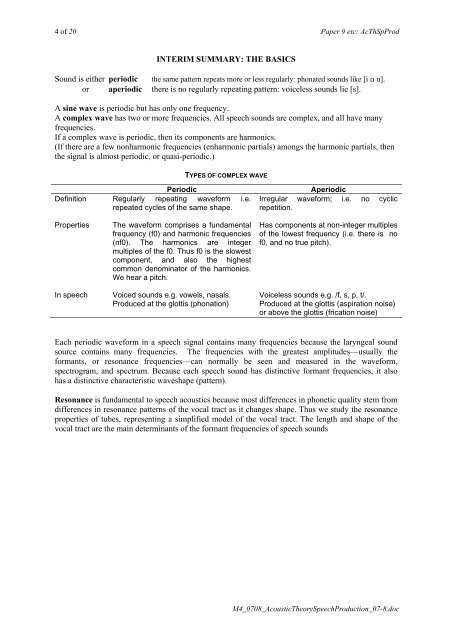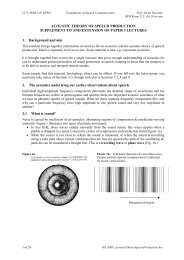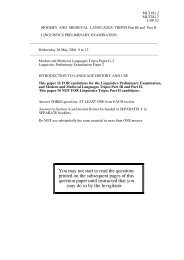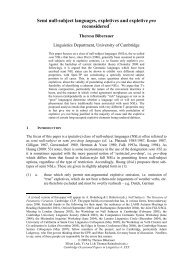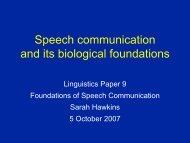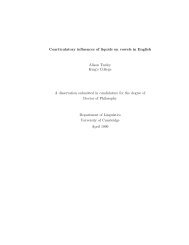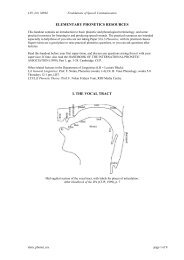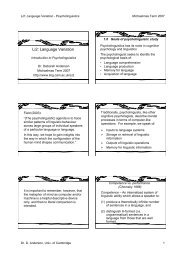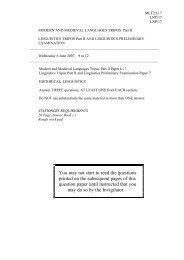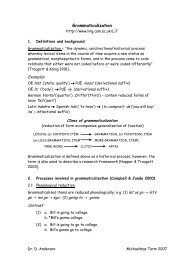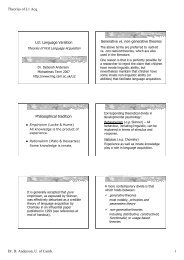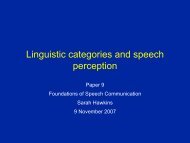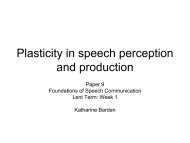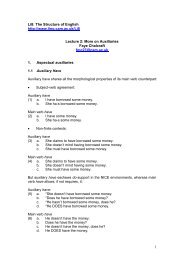ACOUSTIC THEORY OF SPEECH PRODUCTION ... - Ling.cam.ac.uk
ACOUSTIC THEORY OF SPEECH PRODUCTION ... - Ling.cam.ac.uk
ACOUSTIC THEORY OF SPEECH PRODUCTION ... - Ling.cam.ac.uk
Create successful ePaper yourself
Turn your PDF publications into a flip-book with our unique Google optimized e-Paper software.
4 of 20 Paper 9 etc: AcThSpProd<br />
INTERIM SUMMARY: THE BASICS<br />
Sound is either periodic the same pattern repeats more or less regularly: phonated sounds like [i u].<br />
or aperiodic there is no regularly repeating pattern: voiceless sounds lie [s].<br />
A sine wave is periodic but has only one frequency.<br />
A complex wave has two or more frequencies. All speech sounds are complex, and all have many<br />
frequencies.<br />
If a complex wave is periodic, then its components are harmonics.<br />
(If there are a few nonharmonic frequencies (enharmonic partials) amongs the harmonic partials, then<br />
the signal is almost periodic, or quasi-periodic.)<br />
TYPES <strong>OF</strong> COMPLEX WAVE<br />
Periodic<br />
Definition Regularly repeating waveform i.e.<br />
repeated cycles of the same shape.<br />
Aperiodic<br />
Irregular waveform; i.e. no cyclic<br />
repetition.<br />
Properties<br />
In speech<br />
The waveform comprises a fundamental<br />
frequency (f0) and harmonic frequencies<br />
(nf0). The harmonics are integer<br />
multiples of the f0. Thus f0 is the slowest<br />
component, and also the highest<br />
common denominator of the harmonics.<br />
We hear a pitch.<br />
Voiced sounds e.g. vowels, nasals.<br />
Produced at the glottis (phonation)<br />
Has components at non-integer multiples<br />
of the lowest frequency (i.e. there is no<br />
f0, and no true pitch).<br />
Voiceless sounds e.g. /f, s, p, t/.<br />
Produced at the glottis (aspiration noise)<br />
or above the glottis (frication noise)<br />
E<strong>ac</strong>h periodic waveform in a speech signal contains many frequencies because the laryngeal sound<br />
source contains many frequencies. The frequencies with the greatest amplitudes—usually the<br />
formants, or resonance frequencies—can normally be seen and measured in the waveform,<br />
spectrogram, and spectrum. Because e<strong>ac</strong>h speech sound has distinctive formant frequencies, it also<br />
has a distinctive char<strong>ac</strong>teristic waveshape (pattern).<br />
Resonance is fundamental to speech <strong>ac</strong>oustics because most differences in phonetic quality stem from<br />
differences in resonance patterns of the vocal tr<strong>ac</strong>t as it changes shape. Thus we study the resonance<br />
properties of tubes, representing a simplified model of the vocal tr<strong>ac</strong>t. The length and shape of the<br />
vocal tr<strong>ac</strong>t are the main determinants of the formant frequencies of speech sounds<br />
M4_0708_AcousticTheorySpeechProduction_07-8.doc


